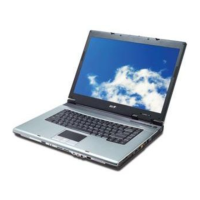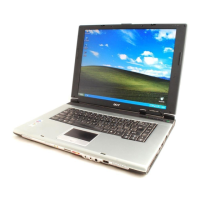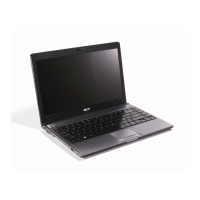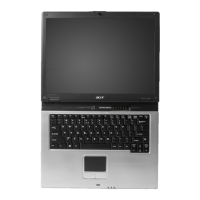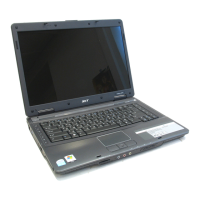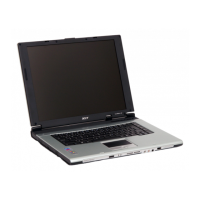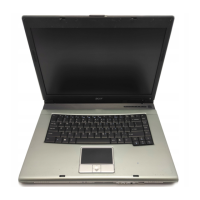Do you have a question about the Acer TravelMate 4150 and is the answer not in the manual?
Details on system features, CPU, chipset, and memory.
Information on screen resolution, type, and graphics processing units.
Details on audio hardware and storage device options.
Specifications for communication interfaces, ports, and battery.
Details on keyboard, physical dimensions, environmental specs, and options.
Illustrates the top side of the mainboard with labeled components.
Illustrates the bottom side of the mainboard with labeled components.
Lists and describes mainboard connectors, jumpers, and chipsets.
Identifies components and indicators on the front of the computer.
Details ports and connectors on the left, right, and rear sides.
Identifies components located on the bottom of the computer.
Explains the function of lock keys and the embedded numeric keypad.
Details Windows key functions and special character input.
Describes keyboard shortcuts for system controls like brightness and volume.
Explains the meaning of various status LED indicators on the computer.
Details the function of the dedicated launch keys above the keyboard.
Guides on using the touchpad for cursor control and scrolling.
Introduces the Acer eManager software for accessing system functions.
Explains how to configure the system's launch keys.
Describes the computer's audio system and how to adjust volume.
Instructions on how to eject the CD/DVD drive tray.
Specifications for the CPU, system core logic, and BIOS.
Details on system memory, LAN protocols, and wireless connectivity.
Specifications for various ports, audio controller, and PCMCIA interface.
Specifications for keyboard, battery pack, and LCD panel details.
Details on the AC adapter and environmental operating conditions.
Guide to accessing and navigating the BIOS Setup Utility.
Explains functionality of power buttons, lid switch, and launch buttons.
Configuration for hard disk and boot passwords within BIOS.
Details on advanced system settings in BIOS, like FIR and USB support.
Explains security parameters including supervisor and user passwords.
Configuration of boot device priority within the BIOS.
Options for exiting BIOS, saving changes, or discarding settings.
Preparation steps and tools needed before disassembling the computer.
Procedures for removing internal components like battery, RAM, CPU, and VGA.
Steps for removing the LCD panel and storage drives (HDD/ODD).
Guides for checking diskette, CD-ROM, keyboard, memory, and touchpad.
Procedures for checking the power adapter and battery pack.
Analysis of POST error messages and error code lists.
Cross-references symptoms to potential FRU (Field Replaceable Unit) replacements.
Techniques for diagnosing intermittent and undetermined problems.
Steps for performing system recovery using the NAPP CD.
Visual representation of mainboard layout with component locations.
Lists and identifies mainboard connectors, chipsets, and items.
Details connector locations on VGA, Power SW/B, Touchpad, ODD, and DVI boards.
Identifies the location for clearing the CMOS settings.
Visual exploded view of the laptop with numbered parts.
List of FRU parts including adapters, batteries, and various boards.
List of FRU parts for cables, chassis, covers, and buttons.
List of FRU parts for LCD panels and mainboard assemblies.
List of FRU parts for memory modules, fans, heatsinks, and speakers.
List of FRU parts for touchpads, miscellaneous items, and screws.
Lists components tested and verified for compatibility with Windows XP.
| Graphics | Intel Graphics Media Accelerator 900 |
|---|---|
| Operating System | Windows XP Professional |
| RAM | 256 MB (up to 2 GB) |
| Storage | 40 GB HDD |
| Display | 15.0" XGA TFT LCD |
| Display Resolution | 1024 x 768 |
| Audio | Built-in speakers |
| Wireless LAN | 802.11b/g |
| Modem | 56K V.92 modem |
| Ports | 3x USB 2.0, VGA |
| Battery | Li-Ion |
| Hard Drive Interface | ATA/IDE |
